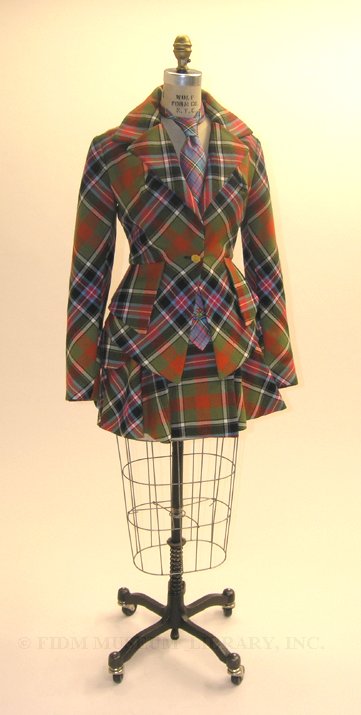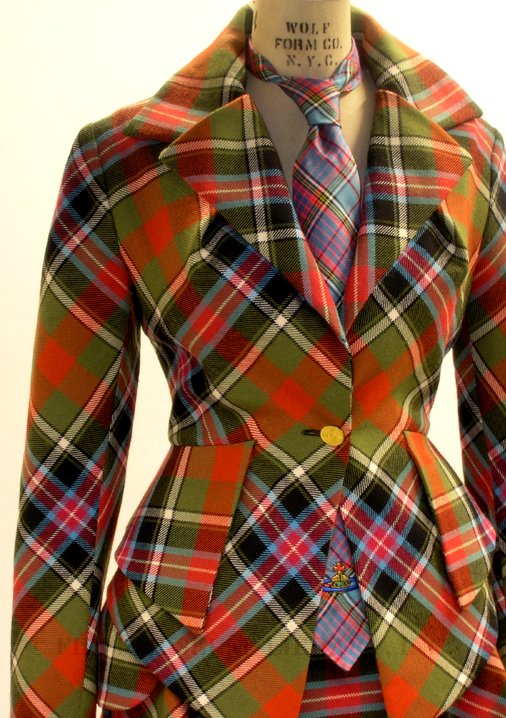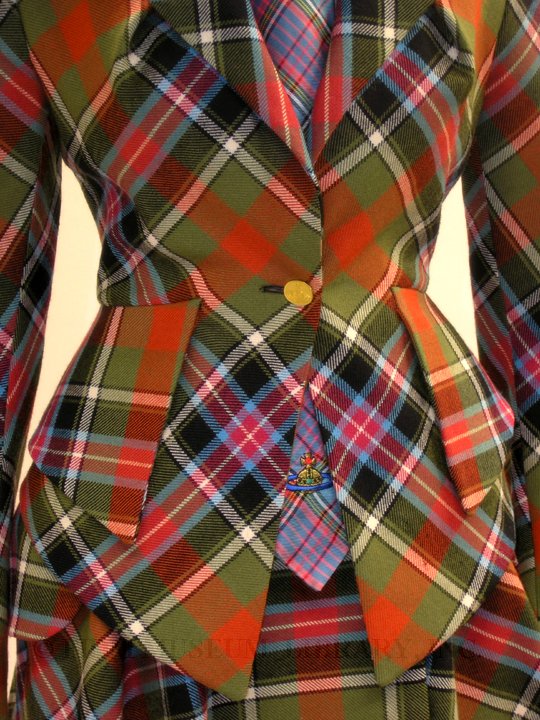British designer Vivienne Westwood (b.1941) began her fashion career in the early 1970s, just as the prevailing fashions began a shift towards the aggressive look of punk. Embracing a design sense that explored the possibilities of decay and destruction, punk was a challenge to the concept of clothing as a means to beautify the individual. Though Westwood did not single-handedly generate the edgy and confrontational look of punk, her early work is closely associated with the visual essentials of punk style, including bondage references and intentionally ripped or torn fabrics. While these design features may seem almost commonplace today, in the late 1970s they were a radical departure from the romantic and non-Western influences present in late sixties style. This new look was simultaneously shocking and influential.
Two-piece suit with tie
Vivienne Westwood
Autumn/Winter 1993
2004.5.61A-C
Museum purchase
In the 1980s, Westwood began mining art history for design inspiration. Using historic garments and paintings as a starting point, Westwood created designs that showcased historic styles, such as corsets and crinolines. She became deeply interested in British fashion traditions, including tailoring and the use of woolen fabrics. Yet, Westwood’s designs were still infused with a quirky and challenging sensibility. Her Anglomania collection from 1993 was a standout, demonstrating a sophisticated merging of her punk sensibilities with her more conservative interests. In a review of the Anglomania runway show, New York Times fashion critic Bernadine Morris credited Westwood with a “divine lunacy” and called the collection “lovable and slightly batty.”1
Given that Westwood’s early career was rooted in an anti-establishment position, this two-piece suit almost seems like a rejection of her early interests. Crisp and precise, it is a definite tribute to the traditions of British tailoring, known as the best in the world. With the plaid perfectly matched at all seams, the jacket appears to have been made from a single, seamless piece of fabric. The “minikilt” skirt is extremely short and though the suit is clearly intended for a woman, it includes a necktie, an accessory that is still associated primarily with men. The orb logo seen at the tip of the tie is both Westwood’s logo and a reference to Harris Tweed, a venerable Scottish mill.
Despite its fine construction and somewhat conservative tartan, there is something cheeky about the look of this suit that suggests Westwood’s punk origins. Plaid was a popular pattern among devotees of punk fashion, and though this particular tartan was commissioned by Westwood for use in her Anglomania collection, its usage is a nod to punk. Outfits from this collection were paired with exaggerated, brilliantly colored platform shoes, which caused model Naomi Campbell to fall during the runway presentation. The shoes were miles away from the sturdy, sensible shoes associated with both suits and tartan. This combination of multiple and conflicting references is true to punk style, which depended on a combination of diverse elements for its confrontational value.
Though Westwood’s design sensibility has matured, it is clear that her early years as a punk designer deeply inform her current work. The challenge present in this outfit is subtle and playful yet true to Westwood’s punk origins. Clearly, you can take Vivienne Westwood out of a ripped and torn T-shirt, but you can’t take the punk sensibility out of her creations.
1 Morris, Bernadine. “Eccentrically or Lushly, All of it Fits.” The New York Times 18 Mar. 1993.: C1.




